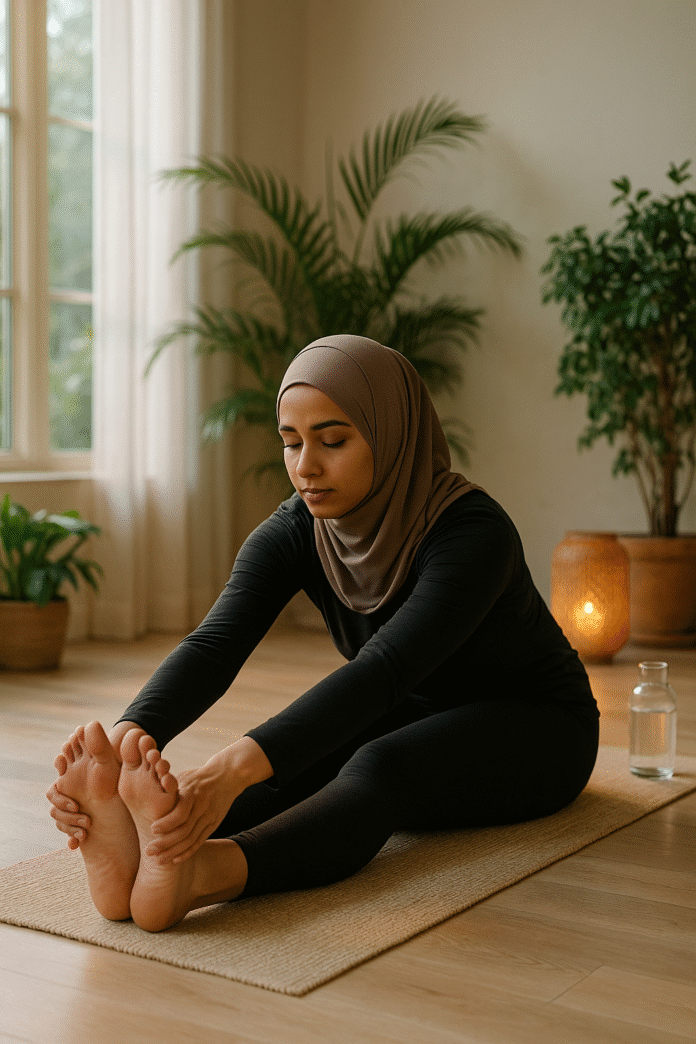In today’s fast-paced world, it’s easy to become stiff, tense, and fatigued from long hours spent sitting at a desk or engaging in repetitive tasks. A daily stretching routine is one of the simplest yet most effective ways to improve flexibility, reduce stress, and enhance overall well-being. Stretching helps release muscle tension, increase range of motion, and promote relaxation—leading to a healthier, more balanced lifestyle.
Whether you are looking to alleviate stress, improve posture, or simply feel more relaxed and rejuvenated, a daily stretching routine can work wonders. Below is a simple yet comprehensive stretching routine you can do every day to enhance your flexibility and reduce stress.
1. Neck Stretch
Purpose: Relieve tension in the neck and shoulders, which are often affected by stress and poor posture.
- Sit or stand tall with your back straight.
- Gently tilt your head toward one shoulder, aiming to bring your ear closer to your shoulder (without forcing it).
- Hold for 20-30 seconds, then switch to the other side.
- You can also add a gentle stretch by placing the opposite hand on your head for a deeper stretch.
Benefits: This stretch targets the muscles in the neck and shoulders, helping to alleviate the tension caused by stress or long periods of sitting.
2. Shoulder Rolls
Purpose: Release tightness and tension in the shoulders and upper back.
- Stand or sit with your back straight and relaxed.
- Slowly roll your shoulders forward in a circular motion 5-10 times, then reverse the direction and roll them backward for 5-10 repetitions.
- Breathe deeply as you move your shoulders, allowing the tension to melt away.
Benefits: This stretch improves blood circulation and relaxes the upper body, reducing stress and promoting better posture.
3. Cat-Cow Stretch
Purpose: Improve flexibility in the spine and relieve tension in the back and neck.
- Start on your hands and knees in a tabletop position (hands aligned under shoulders, knees under hips).
- Inhale as you arch your back, lifting your chest and tailbone (this is the “cow” position).
- Exhale as you round your back, tucking your chin toward your chest (this is the “cat” position).
- Repeat this motion for 10-15 breaths, flowing between the two positions.
Benefits: The cat-cow stretch improves spinal flexibility, releases tension in the back and neck, and massages the internal organs, promoting better digestion and stress relief.
4. Seated Forward Fold
Purpose: Stretch the hamstrings, lower back, and calves, while also calming the nervous system.
- Sit on the floor with your legs extended straight in front of you.
- Inhale and lengthen your spine, then exhale as you hinge at your hips and reach your hands toward your feet.
- Keep your spine straight, and bend only as far as is comfortable for you. Hold the stretch for 20-30 seconds, breathing deeply.
- If you cannot reach your feet, you can use a yoga strap or towel around the soles of your feet to deepen the stretch.
Benefits: This stretch targets the hamstrings, lower back, and calves, helping to release tension in the lower body. It also promotes relaxation and calms the mind, making it an excellent stress-relieving stretch.
5. Chest Opener Stretch
Purpose: Counteract the effects of slouching, open up the chest, and improve posture.
- Stand tall or sit with your back straight.
- Clasp your hands behind your back and straighten your arms.
- Inhale as you lift your chest and gently pull your hands away from your body, opening up the chest and shoulders.
- Hold for 20-30 seconds, breathing deeply and relaxing into the stretch.
Benefits: This stretch helps open up the chest and shoulders, improving posture and relieving tension in the upper body that can arise from sitting or hunching over a desk.
6. Standing Forward Fold
Purpose: Release tension in the lower back, hamstrings, and neck, and improve flexibility in the spine.
- Stand with your feet hip-width apart and bend forward at the hips, reaching your hands toward the floor.
- Keep your knees slightly bent if necessary, and let your head hang freely toward the ground.
- Hold for 20-30 seconds, and gently sway from side to side to release tension.
Benefits: This full-body stretch helps to release lower back tension, lengthen the hamstrings, and relax the neck and shoulders, providing a calming and stress-relieving effect.
7. Hip Flexor Stretch
Purpose: Stretch the hip flexors, quads, and lower back, which are often tight due to prolonged sitting.
- Start in a lunge position with one foot forward and the other knee resting on the floor.
- Keep your torso upright and gently press your hips forward, stretching the hip flexors of the back leg.
- Hold for 20-30 seconds, then switch sides.
Benefits: This stretch targets the hip flexors, which can become tight from sitting for extended periods. It also helps to release tension in the lower back and thighs, promoting overall flexibility and stress relief.
8. Child’s Pose
Purpose: Relax the entire body, particularly the back, hips, and thighs.
- Start on your hands and knees, then sit back on your heels, extending your arms in front of you on the floor.
- Let your forehead rest on the mat and breathe deeply, relaxing into the stretch.
- Hold for 30 seconds to 1 minute, allowing the body to release any remaining tension.
Benefits: Child’s pose is a deeply calming stretch that promotes relaxation and helps relieve stress. It gently stretches the hips, back, and thighs, and is a great way to center yourself during or after a stressful day.
9. Seated Spinal Twist
Purpose: Stretch the spine, shoulders, and back muscles, improving flexibility and relieving tension.
- Sit on the floor with your legs extended in front of you.
- Cross one leg over the other, placing the foot flat on the floor.
- Inhale as you lengthen your spine, and exhale as you gently twist your torso toward the bent knee.
- Hold for 20-30 seconds, then switch sides.
Benefits: This stretch helps to improve spinal flexibility, release tension in the back and shoulders, and aids digestion by gently massaging the internal organs.
10. Legs Up the Wall (Viparita Karani)
Purpose: Relax the nervous system, relieve stress, and improve circulation.
- Lie on your back with your legs extended up against a wall, keeping your arms relaxed at your sides.
- Close your eyes and focus on your breath, allowing your body to relax into the stretch.
- Hold for 5-10 minutes, breathing deeply and letting go of tension.
Benefits: This restorative pose helps to improve circulation, reduce swelling in the legs, and calm the nervous system. It is an excellent way to de-stress and relax at the end of a long day.
Conclusion
Incorporating a daily stretching routine into your day is an effective way to improve flexibility, reduce muscle tension, and promote stress relief. Regular stretching helps to counteract the negative effects of sitting, improves posture, and enhances overall mobility. Whether you have 10 minutes or 30 minutes to spare, the routine above offers a variety of stretches that can be done anywhere, anytime. By making stretching a daily habit, you’ll feel more relaxed, flexible, and energized, supporting both your physical and mental well-being.



